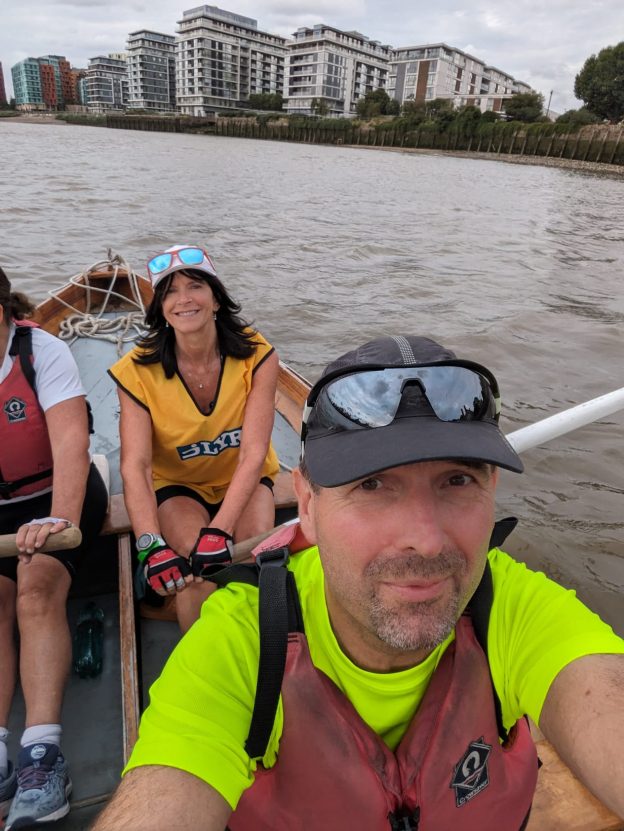Thinking of signing up to the Oarsome Challenge rowing event? Wondering what you’re letting yourself in for?
If sightseeing, with your butt on a hard bench while you manoeuvre a heavy oar through the rolling waters of central London appeals – you could be a candidate for the annual Oarsome Challenge.
I took part in this year’s event – read on for my first-timer Oarsome Challenge rowing tips.
What is the Oarsome Challenge?
The Oarsome Challenge is a charity team rowing event that rides the flood tide along the Thames right through the middle of historic London, starting in Greenwich and ending some 28km upstream at Chiswick Bridge.

You’ll be rowing sweep in a crew of eight, plus steering cox, using a single oar in a fixed-seat, broad-beamed, robust wooden vessel. Previous rowing experience is not necessary, although every crew is required to attend an organised training session before the day of the Oarsome Challenge.
The event raises money for London Youth Rowing (LYR) and the course consists of two parts. The Challenge kicks off with a rare chance to row safely through the Pool of London, where rowing is normally prohibited on safety grounds. The second stretch is a timed race from Putney Bridge to the finish line just short of Chiswick Bridge.
Racing is optional, but all boats need to complete the course.
How long will the Oarsome Challenge take?
The first 20km is rowed in a group, so you can only progress as fast as the slowest boat. The whole course, including the race section, will take between three and four hours.
The good news is it ends with refreshments (beers and pizza this year) and prizes on the foreshore just beyond Chiswick Bridge. It’s the same pretty spot – Quintin and MAABC boat houses – where crews land after the annual University Boat Race.
Be prepared for sore arms, knees, back and butt by the end of your Oarsome Challenge outing.

What should I wear?
The event takes place on a summer evening, when the days are longer and the air is warmer. Row boats aren’t allowed under Tower Bridge until after 6pm, and organisers plan the start time so you’ll be riding with the tide all the way. So odds are you will be rowing from late afternoon until around 8pm. Dress accordingly.
There’s a prize for the best fancy dressed crew. However, make sure that your outfit can withstand three hours plus of rowing motion and non-stop exercise.
Top tip: Loose fitting clothing is at risk of getting caught on your oar, so the kind of fit kit you’d wear for cycling or running is a good choice. Padded cycling shorts are perfect.
Buoyancy aids are compulsory (and provided), so bear in mind that your chest and back will be covered – jackets also provide extra insulation so a thin sweat-wicking T-shirt will be enough for most rowers. Take a small waterproof bag in the boat with a thin, splash-proof jacket or cover-up. There will be time to pause and put it on if necessary. There is also plenty of space to stash bags under your seat.
A well-fitting hat is a good idea – something that won’t blow off – and a pair of padded cycling gloves will ease hand discomfort. Good quality sunglasses will protect your eyes from the potentially damaging glare of sun on water, even on an overcast day. And you must of course wear sun cream, even on a dull day.
Make sure you have a warm cover-up available after you finish – you will cool down quickly once you’ve stopped exercising. Stick a hoody or fleece in your transport bag.

What should I take?
Oarsome Challenge organisers will transport your bags from the start to the finish point, but there are some essentials you will want to keep with you in the boat. Here’s what to take on board:
- Footwear you don’t mind getting wet. Your feet will get wet climbing from shore into your boat and out again at the other end. Wear old, comfortable trainers – or wellies for embarkation, carrying your trainers to put on once you’re in your seat.
- Top tip: A seat pad – use gaffer tape to attach it to the seat bench. You can get specific rowing seat pads, or use the kind of seat that goes on a garden bench, or a pad you might kneel on for gardening.
- A waterproof pouch for your phone that you can wear round your neck / clip round your waist
- A large sports water bottle to keep you hydrated en route
- Energy snacks that are easy to grab on the move. Jelly beans, dried fruit, energy bars all fit the bill.
- Lip balm
Will the Oarsome Challenge hurt?
The fitter you are, the less arduous you will find the event. On-water rowing is the best preparation you can do, with row machine training next best. Any cardio work like running or cycling will help build up your lung power and endurance. Focus on arms and legs if you’re in the gym.
And yes, it will hurt! Don’t underestimate the achievement of completing your Oarsome Challenge – 28km is a very long stretch even for an experienced, regular rower.
However, the picturesque river journey through iconic, historic London along with friendly competition from other boats and the motivation of raising money for charity should help keep your mind off the muscle strain.

Would I take part in the Oarsome Challenge again? Definitely. It was a privilege to row a route that few people get to experience and a team achievement to complete the course and finish in winning position. Thoroughly recommend.



